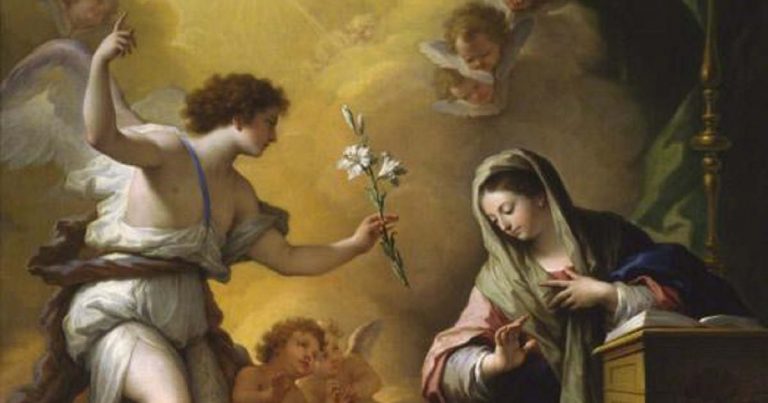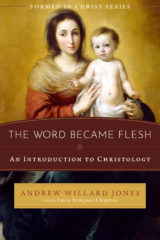By Andrew Willard Jones
Dr. Andrew Jones holds a PhD in Medieval History from Saint Louis University and is an expert on the Church of the High Middle Ages. He is the author of Before Church and State: A Study of Social Order in the Sacramental Kingdom of St. Louis IX and the pioneer of the Formed In Christ series of faith formation texts, as well as the author of several books in this series.

The Church venerates Mary under the title Theotokos, the Mother of God. This devotion to Mary has always been rooted in devotion to Jesus himself. If Jesus was truly man and truly God in one person, and Mary was the mother of that person, then it is absolutely right to say that Mary is the Mother of God.
In addition to calling Mary the Mother of God, the Church also describes her as the New Eve. Eve said no to God in the garden of Eden when she disobeyed him, and through this disobedience, death entered the world. Mary, on the other hand, said yes to God. At the Annunciation, Mary said to the Angel Gabriel, “Behold, I am the handmaid of the Lord; let it be done to me according to your word” (Luke 1:38). Through this yes, the Savior of the human race entered the world, and death was defeated. This is why Mary is the New Eve, the perfect woman through whom the New Adam, Jesus, the perfect man, entered the world.
Pope St. John Paul II explained it this way in his encyclical on the Blessed Mother, Redemptoris Mater:
This fiat of Mary—“let it be to me”—was decisive, on the human level, for the accomplishment of the divine mystery. There is a complete harmony with the words of the Son, who, according to the Letter to the Hebrews, says to the Father as he comes into the world: “Sacrifices and offering you have not desired, but a body you have prepared for me. . . . Lo, I have come to do your will, O God” (Heb. 10:5–7). The mystery of the Incarnation was accomplished when Mary uttered her fiat: “Let it be to me according to your word,” which made possible, as far as it depended upon her in the divine plan, the granting of her Son’s desire.
At the Annunciation, the angel referred to Mary as “full of grace.” The Church connects this greeting to her understanding that through grace, Mary was preserved from all sin from the moment of her conception, even original sin. This is the Catholic dogma of the Immaculate Conception. This might seem like a strange or difficult dogma, and most Protestant Christians today deny it. Nevertheless, many reasons exist that can help us make sense of the Immaculate Conception and understand it as a necessary development of the dogma of the Incarnation.
The first reason goes back to Mary’s role as the New Eve. Eve, of course, was created without original sin. She made her choice of disobedience while in the state of original grace (CCC 375) and so her choice was totally free. Mary, the New Eve, also needed to make a free choice. Her yes needed to be totally free. Her freedom from sin made that possible.
Second, Scripture testifies that nothing unclean or unholy can touch God. Consider the story of Nadab and Abihu (Lev 10:1–2), who offered unworthy incense in the Temple and were consumed by fire. Look also at the attention to detail in which the Tabernacle was constructed (Exod 35–40) and all the laws that governed the activity in the Tabernacle (Num 15). This, of course, was a man-made dwelling for God, constructed of cloth and wood, and so it could never really be perfect. Mary, however, was the dwelling place that God made for himself, and God can make something perfect. Mary is God’s most perfect creation because she was made to be God’s dwelling place and mother.
This raises a third point. In the Ten Commandments, God ordered men to honor their mothers and fathers. The Ten Commandments aren’t arbitrary. They are part of God’s rules for living a righteous life—a life that is pleasing to him. Jesus Christ was God, but he was also a perfectly righteous man. How much more could Jesus have honored his own mother than by preserving her from all defects? God created and maintains his mother in perfect communion with him as the perfect woman because he is the perfect Son who honors his mother perfectly.
Mary is the mother of Jesus, and since the Church is the Body of Christ, made up of his adopted brothers and sisters, Mary is also the Mother of the Church. Recall Jesus’ words on the Cross: “When Jesus saw his mother, and the disciple whom he loved standing near, he said to his mother, ‘Woman, behold, your son!’ Then he said to the disciple, ‘Behold, your mother!’ And from that hour the disciple took her to his own home” (John 19:26–27).
In addition to seeing Mary as its mother, the Church also sees Mary as its model. Mary, after all, was totally faithful; she was the first disciple of Jesus. Likewise, the Church itself is totally faithful, and each of the baptized within it are called to total faithfulness. Similarly, Mary brought forth Jesus to the world. The Church, too, brings forth Jesus to the world, both sacramentally in the Eucharist and in proclaiming his Gospel through word and example. Another parallel is that Mary was the perfect mother; she loved her Son to the end and suffered with him. The Church also loves her children to the end and is willing to suffer martyrdom for them. In all these ways, Mary is both the Mother of the Church and the model for the Church. She was the first Christian and the first disciple. With Jesus in her womb, she was a Church of one.
Today, with this understanding of Mary as the Mother of God, the Mother of the Church, and our Mother, her cooperation in the plan of redemption can serve as a model for our cooperation with God in the building up of his kingdom.
You Might Also Like

The Formed in Christ series is a solid and faithful resource that provides a thorough treatment of the Catholic faith and the various branches of theology. In The Word Became Flesh: An Introduction to Christology, Andrew Willard Jones draws on Scripture and the Catechism to answer the question of who Jesus is and what this means for us.

